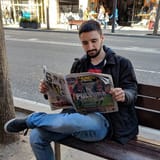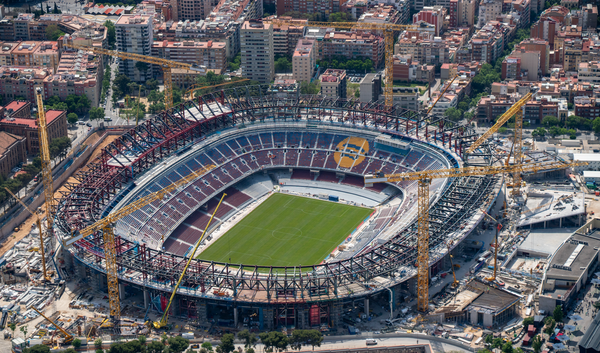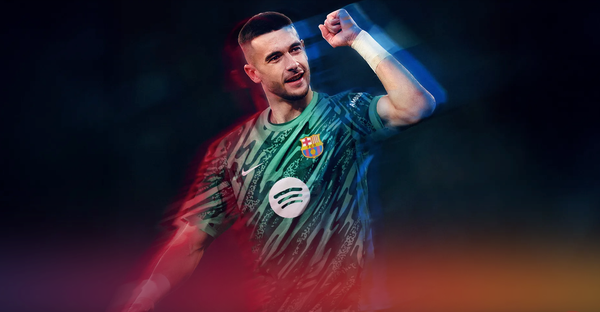Barcelona's midfield: Elite but still far from complete
A midfield trident of Pedri, De Jong and Gundogan is great on paper, but incomplete in practise.
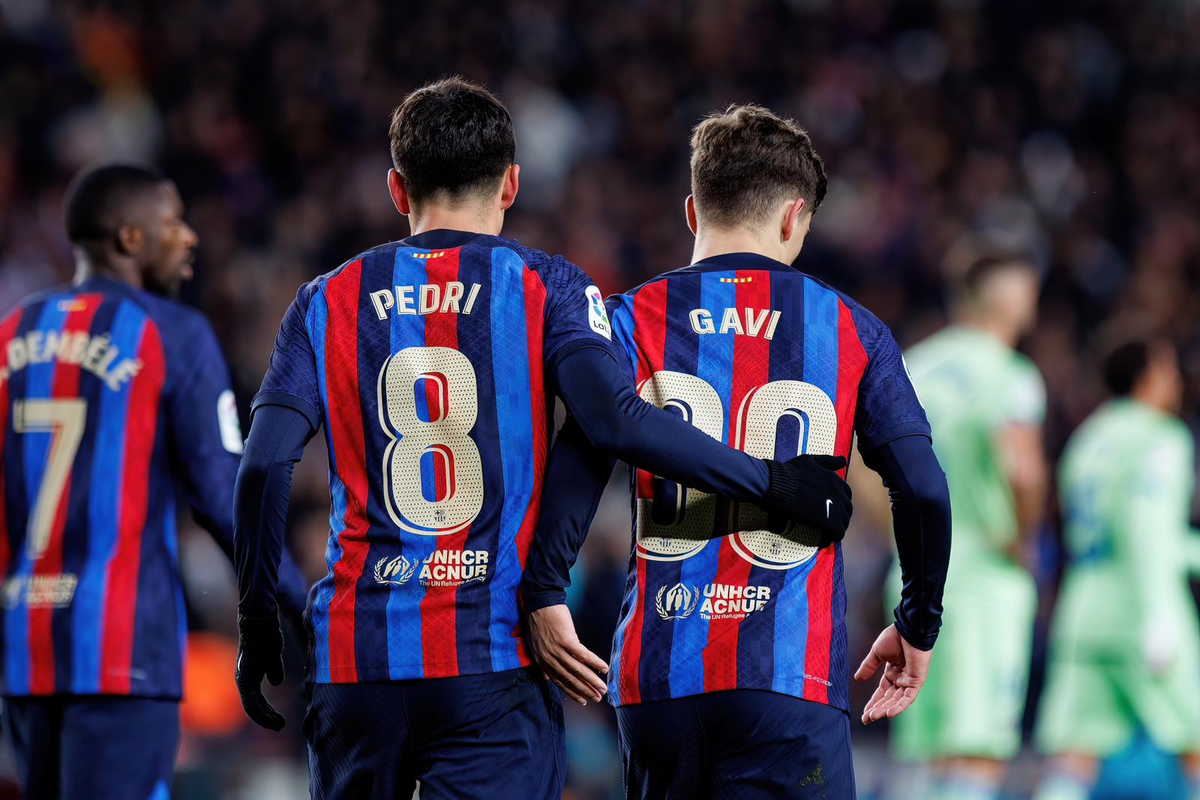
Pedri, Ilkay Gundogan, Gavi, Frenkie de Jong, Fermin Lopez and Oriol Romeu. On the face of it, that is a midfield most teams would sell their souls to have. The technical excellence, the pure quality, the experience, the youth, the elite potential; that roster has one of the best combinations of players on the planet. And they all play for Barcelona.
But if you look beyond the names; if you look beyond their individual attributes, they are still incomplete. Elite, sure, but also incomplete. At the moment, it's challenging for Xavi to field a complementary midfield while using his best players because his best players don't necessarily form his most complementary collective.
So how does he go about solving that issue?
Profiles (or lack thereof)
Between the six players we've mentioned as part of Barcelona's midfield, there is a clear gap in the (single) pivot role. While this comes as no surprise to anyone following the club, it is also a big reason why Xavi is unable to field a fully optimised and balanced midfield without resorting to either a) The double pivot, b) A midfield box or c) A imbalanced midfield setup. Sometimes, these aspects overlap, as is the case with their current best-quality trident.
For all his faults, Romeu is unique within Barcelona's squad. Why? Simple — his profile. He's a pure single pivot with duelling capacity and a preference for recycling, horizontality and a focus on retention. Sure, this means he's less flashy than the others, but that balance is needed as an anchor for the more flamboyant options elsewhere in that midfield.
But while Romeu's profile fits Barcelona's needs, his quality doesn't. He can serve the purpose of a bandaid but can't function as the club's long-term solution for arguably the most important role in the team. And it's his subpar quality that's preventing Xavi from fielding a balanced midfield in the first place. If Romeu was performing better, he'd be a continuous presence in the starting XI simply because the necessity of his profile is so great. However, since he is not, Xavi has to resort to other combinations which bring more quality at the cost of balance.
So in an ideal world, in terms of complementary profiles, Barcelona would field a player of Romeu's profile but much higher quality just behind De Jong and Pedri to maximise their potential. That would solve almost all of their balance issues with a single player. But they don't have such a player. That's why they can't play with a single pivot and must resort to a double pivot to mask Romeu's flaws in possession. But that's not the only issue.
Even if Romeu is partnered with someone like De Jong, which works well on paper and we have seen it work on the pitch too, the former Girona man's mishaps have unfortunately made him a liability even in that setup. Ideally, if it weren't for that, Barcelona would need a player of Gundogan or Fermin's profile - a player with incredible attacking instincts - at the tip of the midfield trident.
As controversial as it may sound, in terms of profiles, Pedri and De Jong would not feature in the same lineup, at least not without a proper holding midfielder anchoring them. Since Barcelona don't have that, they resort to a double pivot and in a double pivot with the third midfielder occupying the 10 role, Pedri is not the ideal profile neither next to De Jong nor at the tip of the setup.
His in-possession tendencies are far too similar to De Jong's while players like Gundogan and Fermin offer more attacking instincts for the advanced role. So in the LCM role, in terms of profiles, Barcelona would have one or the other. But given Romeu's quality (or lack thereof), Xavi has opted for something entirely different. Instead of having balance while sacrificing quality, he has opted for quality while sacrificing balance. And thus, the midfield trident of Frenkie, Gundogan and Pedri was born.
We already discussed why Frenkie and Pedri don't necessarily fit well together in a double pivot. That's why Pedri is now in the 10 role (on paper) and Gundogan is deeper despite his better attacking instincts. The German is someone who can orchestrate from the deep and pull the strings while Pedri gets a free role to influence all phases of play across several channels. This is a midfield dripping with technical excellence but also a midfield missing an engine, ball-winners and natural defenders.
It can and does work as long as Barcelona remain compact, play through them in possession and protect them with a solid structure and rest defence. This season, we have already seen some good and bad examples of how to execute this setup and we saw the good and the ugly side of it.
For better or worse, however, this is the lineup we can expect from Xavi moving forward. So let's analyse it further.
Frenkie, Pedri & Gundogan
A while back, I made a controversial claim stating Barcelona are a team built for technical excellence but not coached for technical excellence. And while we've seen Xavi make strides towards aligning those two, their style of play still often feels suboptimal. Why? Because Barcelona's best players thrive in a completely different environment to the one Xavi has been fostering (for the most part).
It's the same with this midfield trident. Frenkie, Pedri and Gundogan can be a midfield to rule them all. But only if Barcelona play to their strengths. Only if Barcelona use them the way they are meant to be used. We've already highlighted some of the main conditions for their success earlier in the analysis but they boil down to two main ones: control & compactness.
The game against Atletico Madrid gave us an excellent example of using this midfield setup properly. But it took Xavi some time to tweak and make the necessary changes.
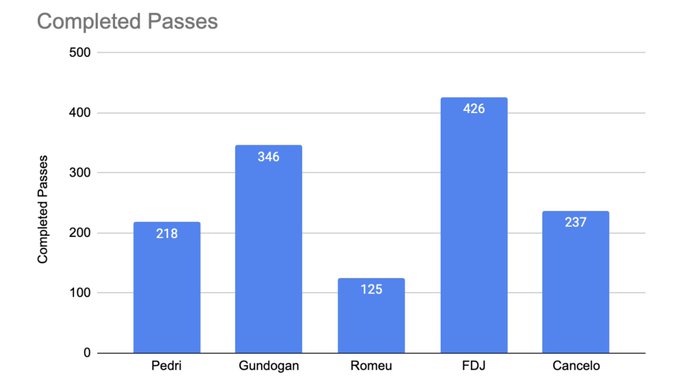
When we look at Barcelona's midfielders' (+ Joao Cancelo) completed passes in their respective last five games before Atletico, we see the number is far too small for certain individuals. Pedri, in particular, was averaging around 43 passes per game in that period while Romeu seemed to be non-existent even if he did play. That was worrying.
And a big reason for that is that Barcelona did not adhere to the two fundamentals we mentioned before: control and compactness. Let's look at their passmaps from the last three games and see the midfield combinations in all of them. Note that we've highlighted only the connections the midfielders had made among each other, not with the rest of the team.
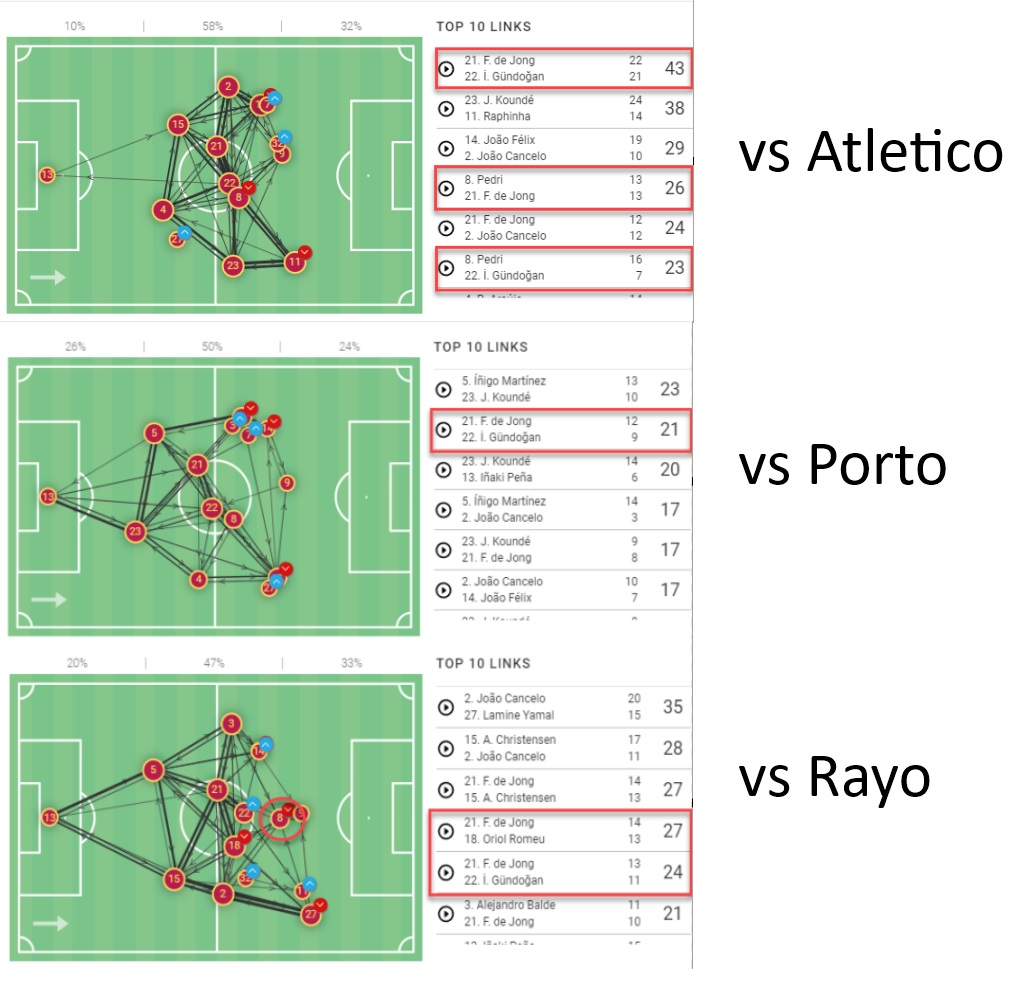
In the game against Rayo Vallecano, Frenkie seemed well connected to both Romeu and Gundogan but that trio couldn't get Barcelona into meaningful positions and Pedri, arguably the most important piece of that puzzle, was completely cut off from them. Against Porto, the midfield could barely connect and even though they are close to each other in average positions, there is a huge gap between them and the forward line, meaning there are barely any links at all.
But then, against Atletico Madrid, all three midfielders are among Barcelona's biggest connections and they are interacting with each other a lot. Not only that but the team is compact and well-linked across the park. That is a great improvement. But it's not just the number of those touches, the areas where they happened also matter.
If we compare two of the extreme cases, one good and one bad, we can see the difference almost immediately. Against Rayo, Pedri and Gundogan are barely involved; the former's touches are sporadic and scattered randomly while the latter is low on volume but also limited to a certain zone of the pitch.
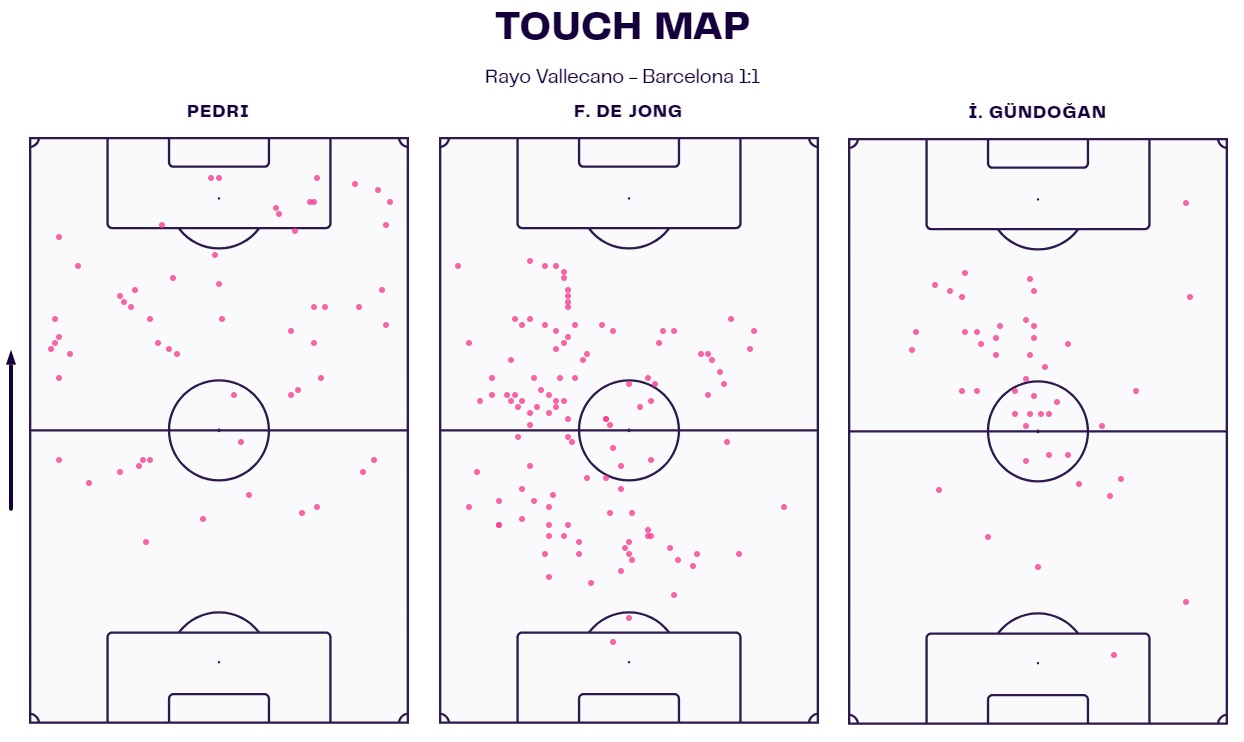
Contrast these touchmaps to the ones we'll see next from the game against Atletico Madrid. All three midfielders are (almost) equally involved and all three are active across the pitch. Instead of using them as a quick transition tool from one third to the next, Barcelona flowed through them at all times, using them as a foundation to build upon rather than a stepping stone.
When they used a compact unit and banked on the technical quality of their midfield, the game was much easier to control. And Pedri, Frenkie and Gundogan? They were at the heart of it.
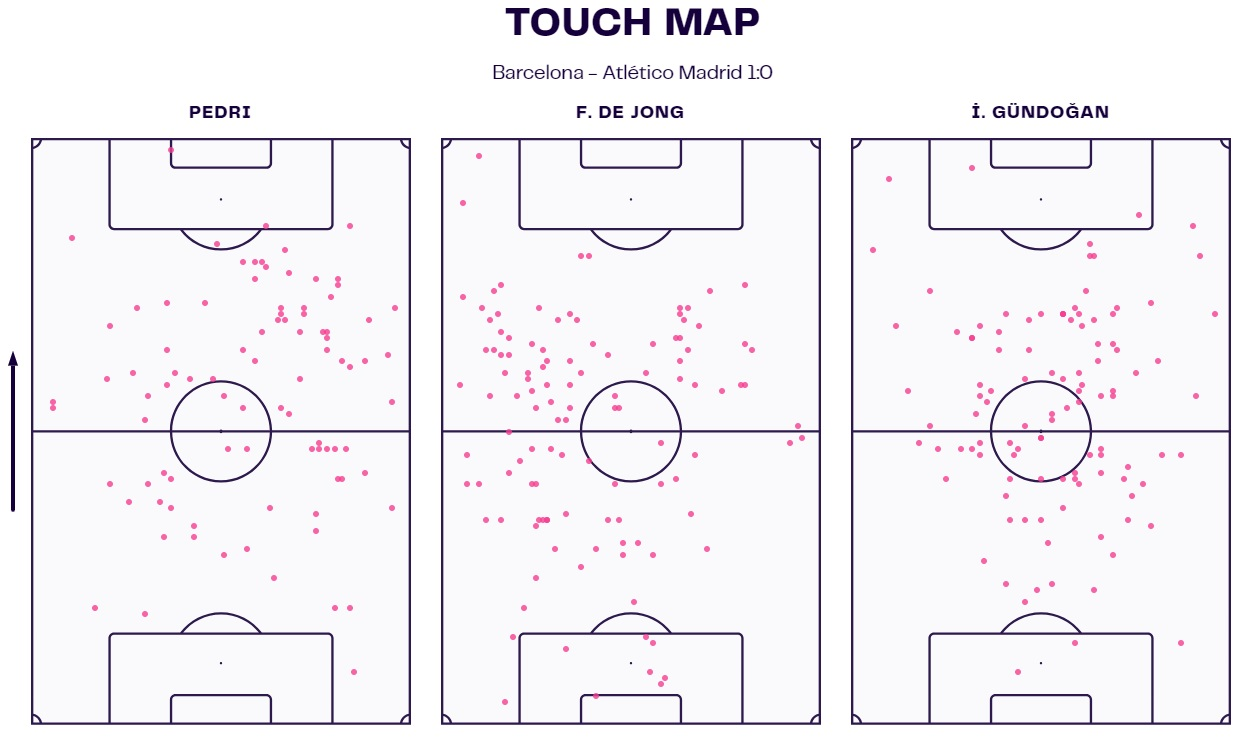
Pedri's touch map, in particular, is a refreshment to see. The earlier experiments with him in the advanced role have mostly seen him isolated and used far too little for a player of his quality. Pedri, for all intents and purposes, is the kind of player who needs to be involved in everything and at all times. Anything less than that is suboptimal. So how has Xavi managed that? Simple - relationships.
Let's start with the basic one - the midfield. Pedri, Frenkie and Gundogan are not the most well-balanced trident in terms of profiles - they are similar in what they want to do and how they want to do it and their strengths don't necessarily cover each other's flaws. This is in part also why Atletico Madrid could get back into the game in the latter stages of the clash.
But back to the main relationship between the midfielders, Xavi has ensured they are near each other (almost) at all times and they were ball-oriented; wherever possession went, that's how the midfielders moved as well.
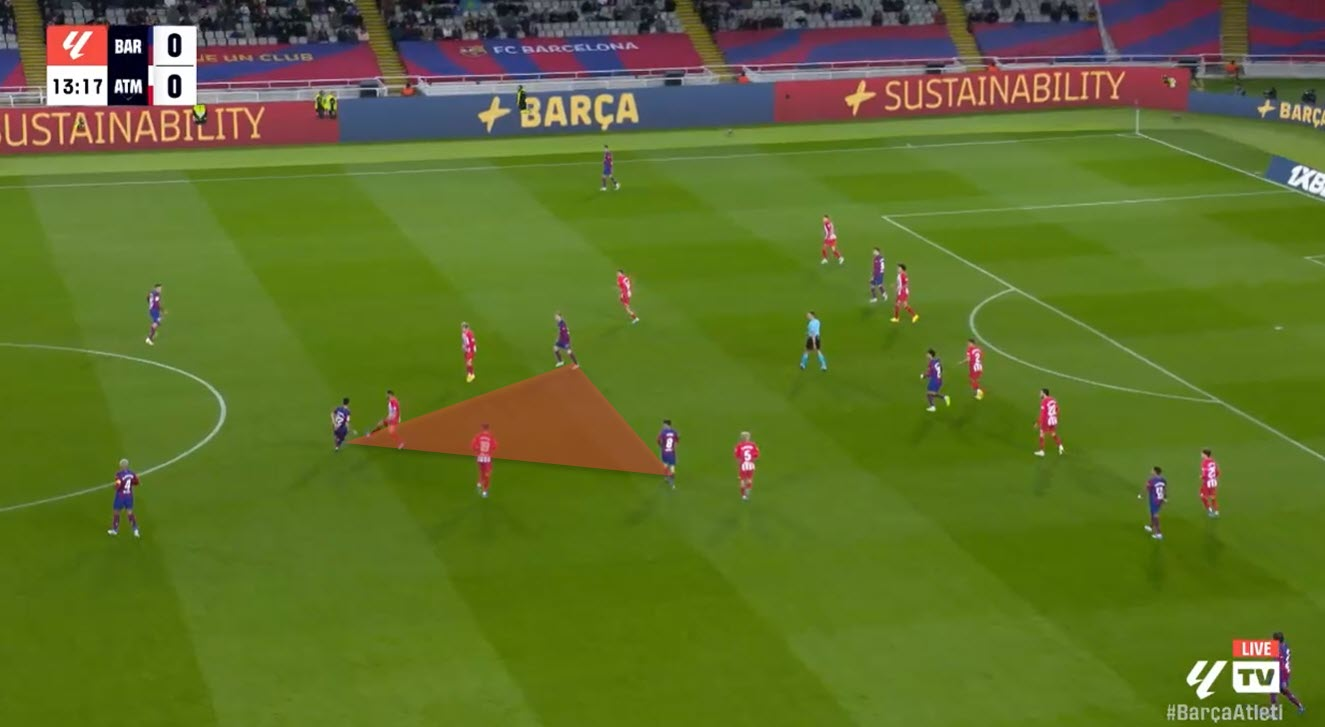
In the most basic of senses, Xavi had to ensure none of them were ever isolated and all of them could be involved in virtually every attack Barcelona had started. And yes, sometimes it's as easy as making sure they are all close to each other and the play flows through them. Barcelona are sometimes guilty of skipping play and exploiting space as quickly as possible, often to the detriment of the players they have in midfield.
The trident in the centre, however, were not only interacting with each other but instead of skipping play in favour of getting the ball forward as quickly as possible, Xavi decided he would involve them as much as possible in as many zones as possible. We already saw that in the touches earlier but it can also be seen in the structure itself.
On the right side, Pedri combined with Jules Kounde and Raphinha (+ Gundogan) while on the left, Frenkie combined with Cancelo and Felix. Down the middle, we have all three of them but with the addition of Felix as well who completes 'the box'.
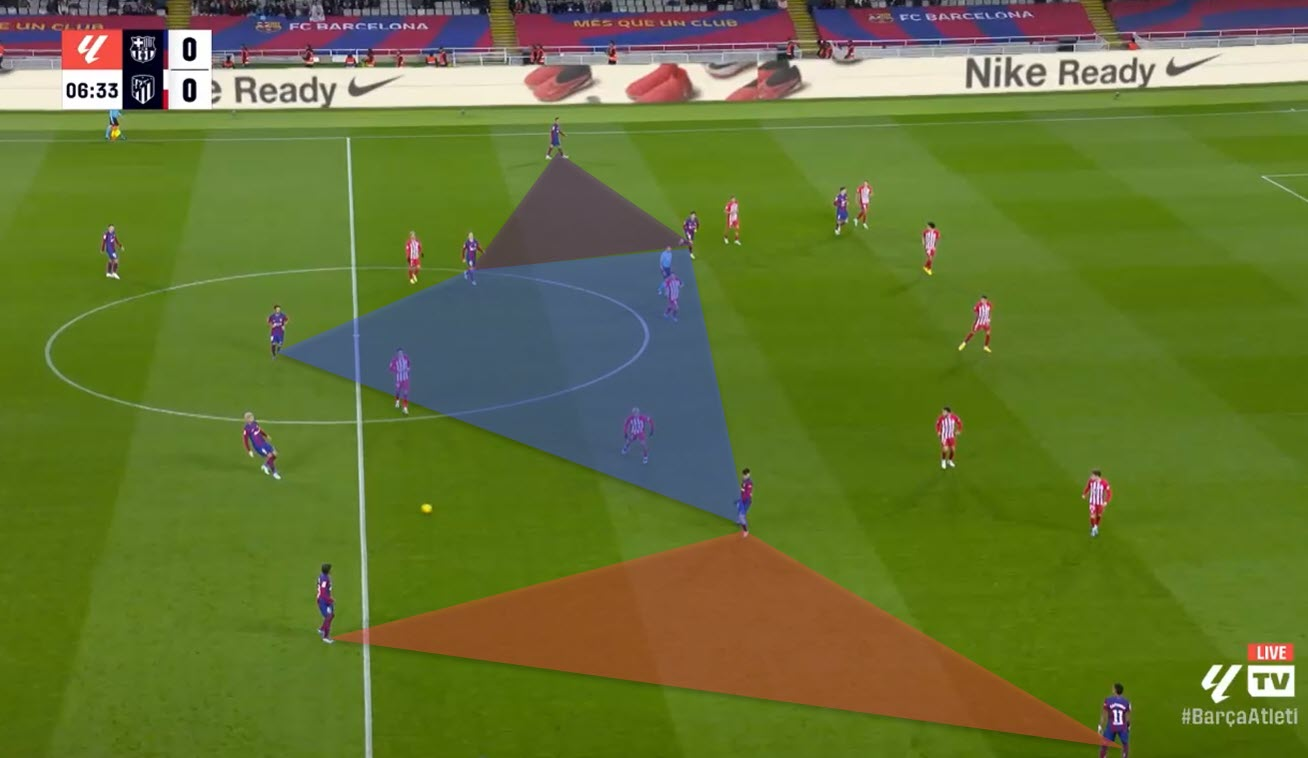
But of all the players, Pedri is perhaps the most interesting one. In this midfield setup, on paper, it's him who's in the most suboptimal role that doesn't necessarily bring out the best out of him. At least that used to be the case in the previous games where the trio had played together. So what changed? Simple, Pedri followed the ball or rather, the ball seemed to follow Pedri. In even simpler words, Barcelona used him the way he's always meant to be used.
And it wasn't just Pedri, the structure around him had shifted to compensate for his movement as well. When the ball was on the right, Pedri would drift wider to the RCM position, when the ball was on the left, he would slide over into the number 10 to come closer to it and if the main distributors behind the attacking unit were in possession, Pedri would attack the box alongside the forwards. Either way, he was constantly available no matter the stage of Barcelona's play.
However, we also have to mention Felix and Lewandowski as both of them created meaningful dynamics with Pedri, adjusting to his movement.
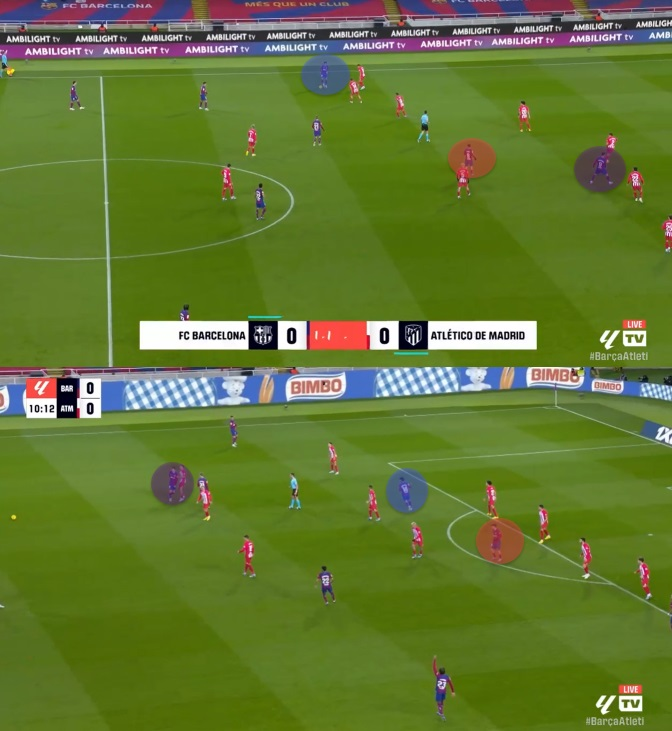
In the images above, Pedri is pictured in red, Felix in blue and Lewandowski in purple. Notice how their positioning changes depending on each other's movement. When Pedri is wide, Felix tucks in centrally and when Felix is wide, Pedri tucks in centrally. If Lewandowski drops deeper, Pedri and Felix both take up a higher and central position to compensate.
And that approach to have both Felix and Pedri constantly gravitating towards the overloaded side as opposed to using them in spurs is giving Barcelona the control and dominance they so desperately want.
Final remarks
As simple as it may sound, all Xavi needed to do was ensure the team plays to their strengths; retain compactness, enable connections, play through your technically superior midfield and do not isolate - and therefore sacrifice - your most important pieces for accessing space more quickly.
Unfortunately, the fact remains that a midfield trident of Pedri, De Jong and Gundogan is incomplete and cracks could be seen in the latter stages of the clash against Atletico Madrid. One way or the other, that will be something for Xavi and the club to address sooner rather than later.
Until then, however, let's hope the win against Atletico Madrid was the start of something truly special.
